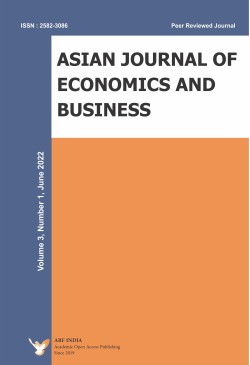
Asian Journal of Economics and Business
Frequency :Bi-Annual
ISSN :2582-3086
Peer Reviewed Journal
Asian Journal of Economics and Business (AJEB) invites submission of papers on theoretical and applied/empirical economics and Business and related all fields, such as accounting that are of high scientific quality. Papers on the policy relevance of the findings are also welcome. The AJEB is an international, Double-blind peer-review journal at the forefront of economic and finance research, fostering discussion on advances in research which have a significant, long-term impact. With papers from both economists and Business experts, AJEB represents a focal point for understanding issues involved in the developments of certain area in economics and finance, providing a global perspective on economic and financial questions at national and international levels.
AJEB journal focuses, but is not restricted, on the following topics:
Accounting, Microeconomics, Macroeconomics, Monetary Economics, Central Banking, Corporate Finance, International Finance, Open Macroeconomics, Economic Policy, International Monetary Systems, Financial Institutions, Banking, International Banking, Banking Regulation, Capital and Money Markets, Real Estate Finance and Investments, Financial Derivatives, Commodity Markets, Theoretical, Applied Econometrics, Public Finance, Fiscal Policy, International Financial Stability, Financial Economics, Islamic finance, Islamic banking, Financial inclusion and entrepreneurship, Business education and statistics and Any other economics or Business discipline
Structure of the Paper and Manuscript Submission Guidelines: Before submission to the editorial staff of the journal, please check Research Misconduct Policies, infringement of which will result in immediate rejection of the manuscript and possible sanctions against the author. The authors are strongly recommended to read the “Guidelines for Authors and Translators of Scientific Articles to be published in English.
Make sure that the manuscript presents an academic value, the significance of the research, as well as that its originality and practical significance are well described; the manuscript makes a contribution to earlier researches concerning the topic. The author must take a close look at the manuscript requirements. Please define the type of the manuscript of possible variants and adhere to both the general guidelines and the recommendations, which are specific for the type of the chosen manuscript.
The following types of manuscripts can be submitted to the journal:
1. research paper, which is a final report on the finished original experimental study;
2. theoretical paper, which is devoted to the theoretical study of the problem, which complies with the journal’s scope (structure of the Theoretical paper – Abstract, Introduction, Theoretical Basis, Results, Discussion, and Conclusion);
3. review paper, which is a study of a concrete scientific problem, which complies with the journal’s scope and is conducted based on the materials of the scientific publications (structure of the Review paper – Abstract, Introduction, Literature review, generalization of the main statements, Discussion, and Conclusion);
Papers for publication should be send by e-mail to the Editor-in-Chief: Dr. Siriyama Kanthi Herath, Associate Professor of Accounting, School of Business, Clark Atlanta University, Wright Young Hall, Room 315, 223 James P. Brawley Dr., S.W., Atlanta, GA 30314, USA e-mail: sherath@cau.edu or editorajeb@gmail.com
Structure of the Research Paper: The presentation of the material in the manuscript should be built on the principle “from the general to the particular”.
The structure of the research paper should consist of the following sections (it does not exclude the presence of additional subsections) – Abstract, Introduction, Methods, Results, Discussion, and Conclusion.
Title: The title of the manuscript should fully reflect the topic of the research and its content. It must be short and concrete (not more than 15 words). Besides, it should catch the reader’s interest and it should be written using the scientific style. It is appropriate to point to the object of research or concretize it using the colon or the brackets. It is not recommended to use contractions, but if used, then only for the commonly known ones.
Author(s): Here the name (first name and last name) of the author (authors) must be written. Those authors who use the patronymic or middle name should write only the first.
Abstract, Keywords, and Abbreviations:
The abstract should be a total of about 200 words maximum. The abstract should be a single paragraph and should follow the style of structured abstracts, but without headings: 1) Background: Place the question addressed in a broad context and highlight the purpose of the study; 2) Methods: Describe briefly the main methods or treatments applied. Include any relevant preregistration numbers, and species and strains of any animals used; 3) Results: Summarize the article's main findings; and 4) Conclusion: Indicate the main conclusions or interpretations. The abstract should be an objective representation of the article: it must not contain results which are not presented and substantiated in the main text and should not exaggerate the main conclusions.
Keywords: Three to ten pertinent keywords need to be added after the abstract. We recommend that the keywords are specific to the article, yet reasonably common within the subject discipline.
Abbreviations
Define abbreviations that are not standard in this field below the keywords of the article. Such abbreviations that are unavoidable in the abstract must be defined at their first mention there, as well as in the footnote. Ensure consistency of abbreviations throughout the article.
References.
References should be listed alphabetically by author at the end of the paper and referred to in the body of the ext by Name (year). The references’ list should be prepared according to the following examples:
Journals paper.
Srinivasan, V. and Shocker, A. D. (1973), “Linear Programming Techniques for Multidimensional Analysis of Preferences”, Psychometrika, 38 (3), 337-396.